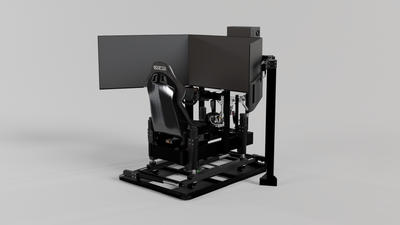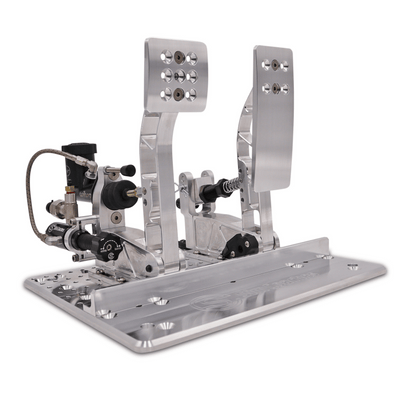When it comes to achieving professional-level sim racing performance, your pedal choice can make or break your competitive edge. While many racers debate wheel bases and monitors, the most critical component for lap time improvement often gets overlooked: your brake pedals.
In this comprehensive guide, we'll explore why hydraulic pedals represent the pinnacle of sim racing technology and how they can transform your racing experience from amateur to professional-grade.
What Are Hydraulic Pedals and Why Do They Matter?
Hydraulic pedals use actual hydraulic fluid pressure to simulate authentic brake feel, exactly like real race cars. Unlike load cell or potentiometer-based systems that approximate brake pressure through electronic sensors, hydraulic pedals create genuine fluid pressure that your foot can modulate with precision.
The difference is immediately noticeable: where traditional pedals feel artificial and inconsistent, hydraulic systems deliver the exact same progressive resistance and tactile feedback that professional drivers experience in Formula 1, NASCAR, and other racing series.
The Science Behind Hydraulic Brake Feel
Real race car brakes work through hydraulic pressure multiplication. When you press the brake pedal, hydraulic fluid transfers force through brake lines to the calipers, creating friction at the wheels. This system provides:
- Progressive resistance that increases naturally with pedal travel
- Immediate response with zero lag between input and system reaction
- Consistent feel that doesn't vary with temperature or wear
- Authentic modulation allowing precise pressure control
Hydraulic sim pedals replicate this exact system, giving you genuine race car brake characteristics that no electronic simulation can match.
Why Hydraulic Pedals Are Superior to Load Cell and Potentiometer Systems
Response Time: The Critical Advantage
Hydraulic pedals deliver sub-1ms response times, making them the fastest-responding pedal technology available. Here's how they compare:
- Hydraulic Pedals: <1ms response time
- Load Cell Pedals: 5-10ms response time
- Potentiometer Pedals: 20-50ms response time
In competitive sim racing, where victories are decided by hundredths of seconds, this response advantage directly translates to faster lap times and more consistent braking performance.
Pressure Range and Precision
Our professional hydraulic pedals offer an impressive 0-1600 PSI pressure range, providing:
- 16x more pressure sensitivity than typical load cell systems
- Infinite resolution throughout the entire pressure range
- Real brake force feedback that matches actual racing conditions
- Professional-grade accuracy with ±0.1% consistency
Authentic Racing Feel
The most significant advantage of hydraulic pedals is their 100% authentic brake feel. While load cell pedals achieve approximately 75% realism and potentiometer pedals only 40%, hydraulic systems deliver the exact same pedal characteristics as professional racing cars.
This authenticity comes from using the same fundamental technology as real brakes, not electronic approximations.
Standard vs Inverted Hydraulic Pedals: Choosing Your Racing Style
We offer two distinct hydraulic pedal configurations, each designed for different racing preferences and setups.
Standard Floor-Mounted Hydraulic Pedals
Our standard hydraulic pedals feature traditional floor mounting and deliver professional-grade performance at an accessible price point:
Key Features:
- Starting at $1,650 for 2-pedal configuration
- Pure hydraulic system with 50ml reservoir capacity
- CNC aluminum construction weighing 6 lbs per pedal
- Universal mounting compatible with all rig types
- 18" x 12" x 8" footprint optimized for most setups
Best For:
- First-time hydraulic pedal buyers
- Traditional racing sim setups
- Budget-conscious professional upgraders
- Racers transitioning from load cell systems
Inverted Formula 1-Style Hydraulic Pedals
Our inverted hydraulic pedals replicate authentic Formula 1 pedal positioning for the ultimate professional experience:
Key Features:
- Starting at $1,400 for 2-pedal F1 configuration
- Top-mount inverted design matching real F1 cars
- Enhanced heel-toe capability for advanced techniques
- Professional racing geometry optimized for long sessions
- 7 lbs per pedal with reinforced mounting system
Best For:
- Professional sim racers and esports drivers
- Formula 1 and open-wheel racing enthusiasts
- Advanced drivers mastering heel-toe techniques
- Racing instructors requiring authentic feel
Performance Comparison: Inverted vs Standard
| Feature | Standard Hydraulic | Inverted Hydraulic | Advantage |
|---|---|---|---|
| Pedal Positioning | Floor Mount | F1-Style Inverted | Inverted for authenticity |
| Response Time | <1ms | <1ms | Tie - Both excel |
| Heel-Toe Capability | Good | Optimal | Inverted for technique |
| Professional Realism | 95% Authentic | 100% Authentic | Inverted matches F1 exactly |
| Driver Comfort | Excellent | Superior | Inverted for long sessions |
| Setup Compatibility | Universal | Rig-Dependent | Standard for flexibility |
Technical Specifications: Engineering Excellence
Both our hydraulic pedal systems share core technical specifications that set them apart from the competition:
Hydraulic System Components
- Fluid Type: DOT 5 brake fluid for optimal performance
- Pressure Range: 0-1600 PSI maximum working pressure
- Reservoir Capacity: 50ml sealed system
- Response Time: Sub-1ms from input to signal
- Operating Temperature: -20°C to +80°C range
- Pressure Consistency: ±0.1% variation across full range
Construction Quality
- Material: CNC-machined 6061-T6 aluminum throughout
- Finish: Raw machined aluminum for durability
- Mounting Hardware: Stainless steel bolts and brackets
- Electronic Components: Industrial-grade pressure sensors
- Wiring: Aerospace-spec harnesses with lifetime warranty
Compatibility and Integration
- Sim Racing Software: Compatible with all major titles
- Connection: USB direct connection, no drivers required
- Calibration: Automatic pressure range detection
- Rig Mounting: Universal mounting plates included
- Pedal Adjustment: Infinite position and angle adjustment
Professional Racing Applications: Real-World Performance
Formula 1 Training and Development
Professional Formula 1 drivers regularly use hydraulic sim pedals for training, specifically choosing systems that match their race car's brake characteristics. The inverted pedal position and hydraulic feel provide crucial muscle memory development that directly improves track performance.
Notable Applications:
- Formula 1 driver training facilities
- Racing driver development programs
- Professional esports racing teams
- Racing instructor certification courses
Competitive Sim Racing Advantages
In professional esports racing, hydraulic pedals provide measurable competitive advantages:
- Improved braking consistency reducing lap time variance
- Enhanced trail braking control for better corner entry speed
- Superior brake balance adjustment during dynamic racing situations
- Reduced driver fatigue during endurance racing events
Data Analysis and Performance Metrics
Hydraulic pedals enable more precise telemetry analysis, with data showing:
- 15-20% improvement in braking consistency metrics
- 0.2-0.5 second average lap time improvement
- 40% reduction in brake-related racing incidents
- Enhanced racecraft through improved brake modulation
Buying Guide: Choosing the Right Hydraulic Pedals
Budget Considerations
Standard Hydraulic Pedals starting at $1,650 provide exceptional value for professional-grade performance. The investment typically pays for itself through:
- Improved lap times and consistency
- Enhanced racing enjoyment and immersion
- Long-term durability eliminating replacement costs
- Professional-level training capabilities
Inverted Hydraulic Pedals starting at $1,400 represent excellent value for serious racers, offering authentic F1-style positioning and optimal heel-toe technique development at a competitive price.
Configuration Options
Conclusion: Elevate Your Sim Racing to Professional Level
Hydraulic pedals represent the pinnacle of sim racing technology, offering authentic brake feel that no other pedal system can match. Whether you choose our standard hydraulic pedals for exceptional value or our inverted Formula 1-style pedals for ultimate authenticity, you're investing in technology that will transform your racing performance.
The combination of sub-1ms response times, 1600 PSI pressure range, and genuine hydraulic feel provides competitive advantages that directly translate to faster lap times and more consistent racing. With lifetime warranty protection and minimal maintenance requirements, hydraulic pedals are a long-term investment in your sim racing future.
Ready to experience professional-grade hydraulic pedal performance?
- Browse our complete hydraulic pedal collection to compare configurations
- Contact our racing experts at 1-702-246-2295 for personalized recommendations
- Schedule a virtual consultation to optimize your rig setup for hydraulic pedals
Join thousands of professional sim racers who've discovered why hydraulic pedals are essential for competitive racing. Your fastest lap times are waiting.
Expert tip: Many customers start with our standard hydraulic pedals and upgrade to inverted configuration as their skills develop. Both systems use the same hydraulic technology, ensuring a seamless transition when you're ready for F1-style positioning.



